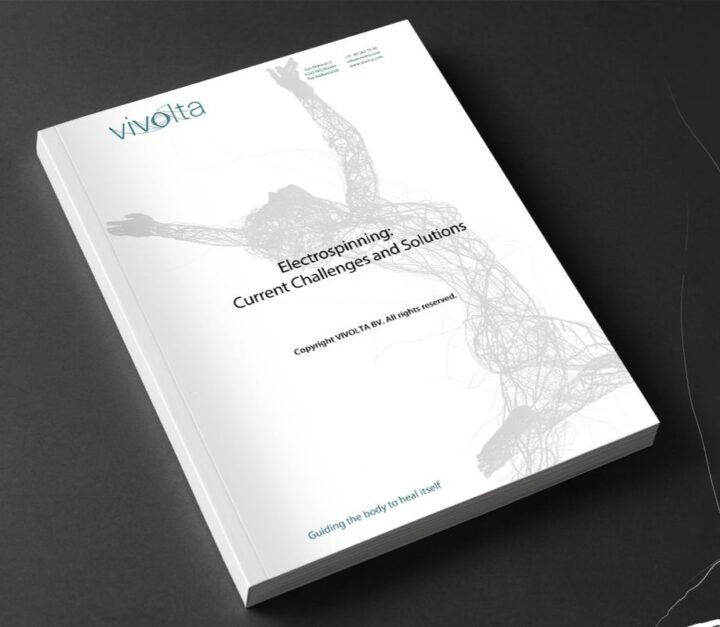Structural Heart, Coronary, Peripheral, Endovascular, Neurovascular
Cardiovascular applications of electrospinning are among the most advanced in translation to clinics (Tozzi et al., 2025). Electrospun vascular grafts and heart valve scaffolds have been developed to tackle the limitations of conventional implants (Kluin et al., 2017). Small-diameter blood-vessel grafts (for coronary or peripheral artery bypass) made from expanded polytetrafluoroethylene (ePTFE) or Dacron often fail in the long term due to poor cell integration, thrombosis, and loss of patency (Dohmen et al., 2013). Electrospun vascular grafts, by contrast, can be engineered to be biodegradable and to promote true vascular tissue regeneration. They typically use polymers like PCL or poly(4-hydroxybutyrate) (P4HB) that gradually degrade over 1–2 years (De Valence et al., 2012). Upon implantation, the fibrous structure encourages infiltration of endothelial cells and smooth-muscle cells from the host, eventually forming a natural blood vessel and leaving no permanent foreign material. A critical design aspect is pore size: standard electrospinning yields very small pores that can impede cell penetration. Researchers have found that increasing fiber diameter into the few-micron range (e.g., 3–6 µm fibers) creates more macroporous graft walls (~20–30 µm pores) which dramatically improve cell ingrowth and vascular tissue remodeling (Cortez Tornello et al., 2018; Uthamaraj et al., 2016). In one study, a PCL electrospun graft with enlarged pores was implanted as an abdominal aorta in rats; the graft remained patent for 12 months with no aneurysm, and by 3 months it was well populated with cells and new tissue with minimal calcification (De Valence et al., 2012). This demonstrates the potential for electrospun grafts to function as a temporary scaffold that is gradually replaced by the body’s own artery – a concept known as in situ tissue-engineered blood vessels. Such grafts (including those by companies like Xeltis) are in early human trials for coronary bypass and dialysis shunts (Tozzi et al., 2025).
For the structural-heart field, electrospun heart-valve scaffolds are a game-changer. Instead of using permanent prosthetic valves, which are either mechanical (requiring lifelong anticoagulants) or biological (fixed animal tissue that can calcify), a bioresorbable electrospun heart valve could be implanted to initially serve as a functional valve and then induce the patient’s own cells to rebuild a natural valve (Kluin et al., 2017). These scaffolds are typically tri-leaflet valve shapes electrospun from elastic polymers; after implantation, blood flow and natural healing processes lead to host-cell colonization. Over time, the scaffold degrades, leaving a living valve tissue. Early prototypes have been tested in sheep with encouraging results – the valves functioned immediately and gradually converted to tissue valves with stable performance (Kluin et al., 2017). Challenges remain in achieving the necessary durability and preventing the scaffold from degrading too quickly, but the prospect of a regenerative heart valve is on the horizon.
In the realm of endovascular and neurovascular devices, electrospun nanofibers are being used to improve stent grafts and aneurysm treatments. For example, stent grafts used in aortic aneurysms can be lined with an inner electrospun layer to make them blood-tight and promote endothelialization (growth of a blood-compatible lining) (Vahabli et al., 2022). In neurovascular aneurysm therapy, a very fine electrospun membrane has been developed to wrap around stents or coils, acting as a flow-diverter that prompts faster clotting of the aneurysm while encouraging tissue healing across the aneurysm neck (W. Liu et al., 2021). Because the brain arteries are small, only an electrospun membrane can provide the necessary thinness and porosity control for this purpose. Another emerging product is an electrospun vascular patch for surgical closure of vessels – these patches have an advantage in that they integrate into the vessel wall over time, unlike conventional plastic patches (Balà et al., 2024).
Overall, in cardiovascular applications, electrospun devices aim to meld the mechanical support of a synthetic implant with the long-term benefits of regenerated, living tissue. By fine-tuning fiber architecture (e.g., radial alignment of fibers to mimic arterial circumferential strength) and material properties (e.g., using elastic, biodegradable polymers), researchers have created vascular grafts and valve scaffolds that closely emulate the behavior of native tissue and invite the body to heal. The clinical benefits could be profound: patients may receive an implant that self-heals and lasts a lifetime, rather than requiring replacement or causing life-threatening complications during long-term use.





